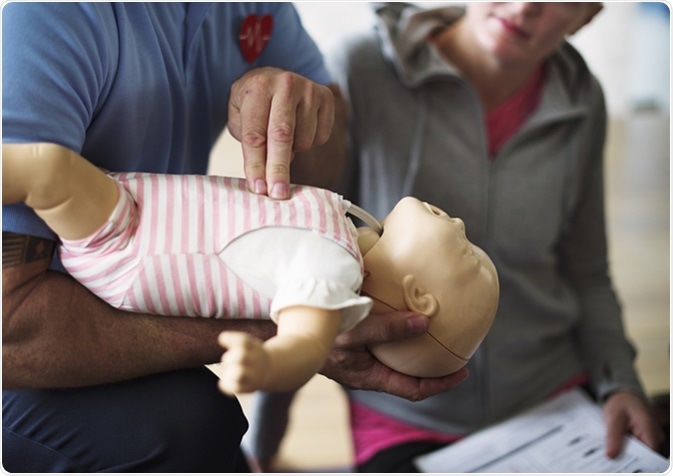Cardiopulmonary resuscitation (CPR) may be required in the event that a baby stops breathing or the heart stops beating. CPR is a procedure of supplying oxygen through the lungs and blood flow through the heart until medical care is administered or until a cessation is indicated.
CPR may be needed in many situations, such as following a rescue of a baby from drowning, choking, severe hemorrhage, or suffocation. Electrocution, head trauma, and poisoning are other conditions in which a baby may require CPR resuscitation.
Permanent brain damage and death could occur within four and six minutes of brain oxygen deprivation, respectively; however, such detrimental outcomes can be prevented by CPR. Thus, it is a vital step in emergency care for a baby who has an undamaged brain and has the potential to fully recover brain function once the critical need is overcome. CPR should be given by a trained person.

Image Credit: Rawpixel.com / Shutterstock
CPR in infants
In the case of babies, CPR should be given for 2 minutes initially, and then the emergency number should be called.
First, the breathing, pulse, and consciousness level of the affected baby should be checked. If these are absent, the baby should be shaken very gently to look for some noise or movement.
If negative, an emergency number should be dialed immediately so that an automated external defibrillator (AED), a machine to restart the heartbeat, can be administered rapidly. In the meantime, CPR should be performed by a trained person for two minutes.
How to Give Baby CPR - First Aid Training - St John Ambulance
Chest compressions
In modern CPR, chest compressions are the most important and early step before securing a patent's airway for breathing or establishing a heartbeat. This is done with two fingers placed on the lower third (not the end) of the sternum, marked by the location just below the baby’s nipples. The infant's head is tilted back gently with the other hand. The chest is compressed to a third or a half of the way down to the spine behind 30 times in quick succession, only allowing the chest to rise completely in between two compressions.
For slightly older or bigger babies, the heel of the hand is preferred to allow sufficient compression. Sometimes, both hands are interlocked to give more force during CPR administration.
The hands are positioned vertically over the sternum. The point of compression should be the breastbone, about an inch above the bottom to avoid compressing the stomach. The fingers should not be included in the pressure to avoid injuries to the ribs.
Rescue breathing (mouth-to-mouth resuscitation)
At the end of 30 compressions, the bony chin is elevated using a hand, while the head is tilted up with a hand on the forehead to straighten the airway. It is important to note that the CPR provider avoids pressing the soft tissue behind the bone, which can block the mouth or cause the mouth to close.
The child is observed for any evidence of breathing for about 10 seconds. Placing the ear near the infant’s nose and mouth to look for any chest movement and placing the cheek near the infant’s mouth and nose to check for breathing are commonly taught methods. It is important to note that irregular gasps are not normal breathing.
If no breath is felt or seen, the mouth and nose are checked for obvious blockage. Afterward, the nose is closed and the mouth is covered by the performer’s mouth to make a seal. Five rescue breaths are given over one second each that are adequate to produce a rise in the chest. This is followed by chest compressions again.
If there is no sign of recovery after two minutes of this combined procedure, calling an emergency number is necessary.
The procedure is continued until medical help arrives, or the baby begins to breathe spontaneously. Every few minutes, the breathing is checked after stopping the procedure. Once the infant coughs, breathes or moves normally, CPR must be stopped immediately. The baby is then turned on to the side if possible and normal breathing is rechecked.
References
Further Reading